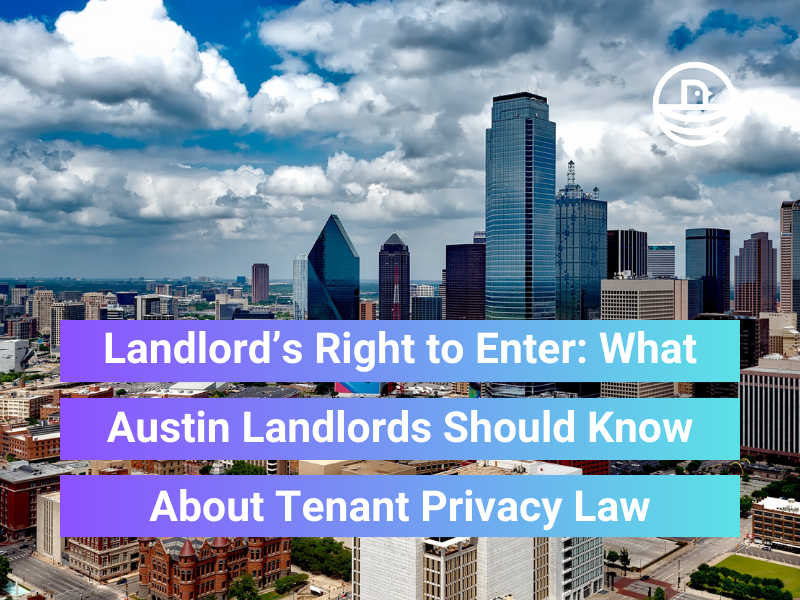In Austin, Texas, renting is common, and both renters and landlords have certain rights. This is especially true when it comes to privacy. For landlords, understanding when you can and cannot enter your rental property is important. Even if a tenant has asked you for a repair, Texas law sets out rules to protect their privacy, meaning you can’t just walk in unannounced.
Knowing the Tenant Privacy Law and planning your lease agreement carefully can help prevent misunderstandings and keep you out of legal trouble. If you’re a landlord in Austin, here’s everything you need to know about your right to enter and how to respect your tenants’ need for privacy.
Understanding the Texas Tenant Privacy Law
The Tenant Privacy Law in Texas is designed to protect tenants’ space. This law states that a landlord’s right to enter a rental property in Austin is limited unless the tenant gives permission or the lease agreement allows it.
For example, if your lease agreement doesn’t specifically mention inspections or repairs, you’ll need permission from your tenant to enter. This law is all about protecting the tenant’s personal space, so setting clear expectations from the start is important. Many Austin renters value their privacy, so taking these steps can help landlords avoid potential issues.
When Does the Landlord’s Right to Enter Apply in Austin?
.png)
So, when does the Tenant Privacy Law in Texas allow landlords to enter a rental property in Austin? The Texas Apartment Association (TAA) provides a template lease agreement commonly used by Austin landlords. This agreement lists 24 specific situations when a landlord's right to enter applies, some of which include:
Replacing smoke detectors
Changing filters
Responding to noise complaints
Removing a safety hazard
The TAA lease agreement lists several other reasons a landlord might enter, but the landlord must be careful not to use these reasons as excuses to enter regularly. The tenant is allowed to refuse entry, but repetitive and unnecessary refusal could be considered breaking the law. Keep in mind that tenants are not required to be home during the landlord’s entry into a rental property in Austin. However, if the tenant isn’t home, the landlord is required to leave a written notice that they were inside the unit.
If you decide not to use the TAA lease agreement, you’ll need to make sure you’ve clearly outlined the landlord's right to enter in your own lease agreement. Otherwise, per the Tenant Privacy Law, you won’t be able to access the property unless the tenant gives you permission.
There are a few exceptions to be aware of when it comes to landlord access. If the lease agreement isn’t clear about the landlord’s right to enter, they can still do so in four specific situations. These include:
Making requested repairs
Doing routine inspections
Helping with an emergency
Posting an eviction notice
If the landlord enters for these reasons, they will not get in trouble with the law. Emergencies in Austin, Texas often include weather-related incidents like tornado or hail damage, burst pipes from winter storms, and flooding—of which nearly 30% of downtown properties are at risk.
Lease Agreement Essentials for Austin Landlords
A strong lease agreement can make or break a landlord’s experience in Austin, Texas—and the tenant’s. The area attracts a mix of professionals, families, and students, meaning tenants may come with different expectations around privacy. Many residents have recently moved to the state and might be coming from a state where laws are stricter or more lenient. A solid lease agreement keeps things straightforward and prevents confusion.
Using the TAA template can be a great starting point, as it covers common reasons a landlord might need to enter while the tenant is renting it out. However, Austin landlords may want to add details and clauses unique to their property or neighborhood. Here are a few Austin-specific situations to consider including in the lease agreement:
Access to shared amenities: In neighborhoods like Hyde Park or Clarksville, some properties have shared yards, driveways, or pools. If you’ll need access to these spaces for any reason, be sure it’s outlined in the lease.
Easements for greenbelt access: Austin is known for its green spaces and hiking areas. If your property has an easement to access public land or trails, such as the Barton Creek Greenbelt, clearly outline these terms so your tenant understands when you might need access.
Smart home technology: Many modern rentals in areas like Mueller come with smart home systems. If you need access for repairs or maintenance on these systems, include it in the lease agreement.
Covering these unique aspects in your lease agreement not only helps you follow the Tenant Privacy Law but also sets clear boundaries for you and your tenants. In Austin, where outdoor activities are highly valued, tenants will appreciate a lease that respects their privacy while also being specific about necessary landlord access.
Landlords in Austin, Texas are required to fix anything that "materially affects the physical health or safety of an ordinary tenant." Because Austin is prone to high heat during summers, landlords may need to enter more often to ensure tenant safety and comfort by fixing HVACs, so it’s important to make entry rules clear.
It can also be beneficial to include an “advanced notice” clause in your lease agreement. While Tenant Privacy Law doesn’t require 24-hour notice before entry, many Austin renters will appreciate a heads-up, especially if they work from home or have pets. Renters can also specifically request a 24-hour rule for entry if they wish, which landlords must abide by.
When Can Property Managers Enter a Rental Property in Austin?
If you’re working with a property manager for your rental property in Austin, it’s important to know that they have to follow the same rules. A property manager acts on behalf of the landlord, so they must have the tenant’s permission or clear terms in the lease agreement to enter the property.
For instance, companies like Evernest that manage rental properties in Austin are already familiar with both tenant expectations and local laws. They make sure that every lease agreement includes clear entry guidelines that follow the Tenant Privacy Law. Having a property manager with experience in Austin’s rental market helps ensure your property is well cared for and tenant privacy is protected.
Simplifying Tenant Privacy Law with Evernest
In Austin, the Tenant Privacy Law is in place to protect tenants while allowing landlords to manage their property responsibly. Understanding when and how the landlord’s right to enter applies is essential to maintaining a respectful and legal relationship with tenants. Landlords who prioritize tenant comfort with extra steps often find they have a better experience in Austin’s competitive rental market.
If the rules in Austin, Texas feel overwhelming, reaching out to a property manager or legal professional can help. With a property management company like Evernest, landlords can rest easy knowing that all entry guidelines are followed, maintenance requests are handled, and access is managed with professionalism at all times. It’s an easy way to ensure a positive experience for landlords and tenants alike.


